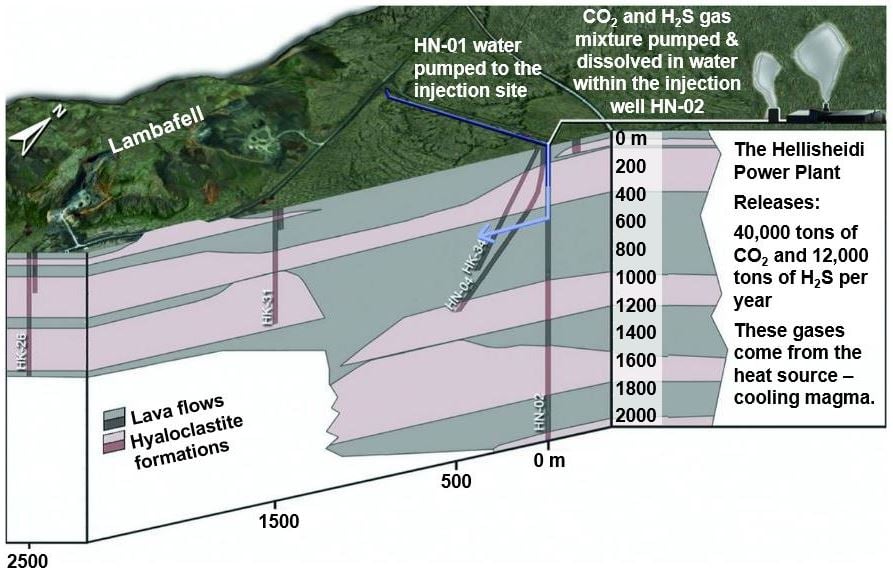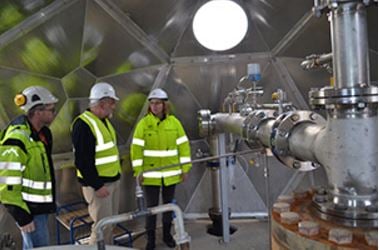Scientists have found a viable way of turning carbon dioxide into rock, specifically carbon dioxide (CO2) caused or influenced by humans – anthropogenic CO2. The international team believes the technology they have created could be a promising measure to combat climate change, also known as global warming.
The international team, with scientists from the UK, the USA, France, the Netherlands, Iceland, Australia and Denmark, explained in the journal Science (citation below) that they have shown for the first time that CO2, a greenhouse gas, can be rapidly and permanently locked away from the atmosphere by injecting it into volcanic bedrock.
The carbon dioxide reacts with the volcanic rock, forming environmentally harmless minerals.
 A geological cross-section of the CarbFix injection site. CO2 and H2S are dissolved in water and then injected in well HN02 at a depth between 400 and 540 m. For this study, fluid samples were collected in the injection well HN02 and the monitoring well HN04. (Image: science.sciencemag.org)
A geological cross-section of the CarbFix injection site. CO2 and H2S are dissolved in water and then injected in well HN02 at a depth between 400 and 540 m. For this study, fluid samples were collected in the injection well HN02 and the monitoring well HN04. (Image: science.sciencemag.org)
CO2 is a greenhouse gas
Carbon dioxide is a greenhouse gas, as are water vapour, methane, nitrous oxide and ozone. They are responsible for the greenhouse effect. The greenhouse effect is a natural process in which a planet’s atmosphere traps some of its parent star’s energy, warming it enough for there to be liquid water, and therefore life.
It is thanks to the greenhouse effect that life on Earth exists. The problem is that we are now releasing too much greenhouse gas into the atmosphere, which is raising the world’s temperature – causing climate change. If the ice around the North and South Poles melts, sea levels will rise considerably and millions of people living on coastal towns and close to sea level will lose their homes.
A warmer planet also means there will be more frequent and severe extreme weather events, changing migration patterns of birds and other animals, and changes in our landscape as plants either disappear or migrate further away from the equator. Climate change is pushing several species of flora and fauna to the brink of extinction.
One approach to reduce how much CO2 we release into the atmosphere is CCS (Carbon Capture and Storage), where carbon dioxide is physically removed from the atmosphere and trapped under the ground.
 Coauthor Sandra Snaebjornsdottir holding an experimental drill core laced with solidified carbonate, apparently produced by a new process that converts carbon emissions to stone when pumped underground: (Image: ldeo.columbia.edu. Credit: Kevin Krajick/Lamont-Doherty Earth Observatory)
Coauthor Sandra Snaebjornsdottir holding an experimental drill core laced with solidified carbonate, apparently produced by a new process that converts carbon emissions to stone when pumped underground: (Image: ldeo.columbia.edu. Credit: Kevin Krajick/Lamont-Doherty Earth Observatory)
Scientists have long-explored the possibility of sealing carbon dioxide gas in underground voids, such as abandoned oil & gas reservoirs. However, so far they have not come up with an effective and permanent solution to leakage.
Mineralisation of carbon
So the focus has now turned to the mineralisation of carbon to permanently dispose of the greenhouse gas (CO2).
Experts have said that the process of mineralisation is far too slow for our needs – it would take many hundreds to thousands of years – and therefore not a practical option, that is, until now.
In this latest study – led by the University of Iceland, University of Toulouse in France, Columbia University in the USA, and Reykjavik Energy in Iceland – scientists have demonstrated that the whole process can be completed in just two years.
Lead author, Dr Juerg Michael Matter, Associate Professor in Geoengineering within Ocean and Earth Science, National Oceanography Centre Southampton at the University of Southampton in England, said:
“Our results show that between 95 and 98 per cent of the injected CO2 was mineralised over the period of less than two years, which is amazingly fast.”
 This image shows part of the piping system that pumps emissions back underground. Left to right, engineer Magnus Thor Arnarson, Lamont-Doherty Earth Observatory hydrologist Martin Stute and project leader Edda Sif Arradotir of Reykjavik Energy. (Image: ldeo.columbia.edu)
This image shows part of the piping system that pumps emissions back underground. Left to right, engineer Magnus Thor Arnarson, Lamont-Doherty Earth Observatory hydrologist Martin Stute and project leader Edda Sif Arradotir of Reykjavik Energy. (Image: ldeo.columbia.edu)
The CO2 was injected into a deep well in Iceland, at the study site. Being a volcanic island, Iceland is made up of 90% basalt, a rock rich in elements – iron, magnesium and calcium – that are needed for carbon mineralisation.
The carbon dioxide is first dissolved in water and then carried down the well. When it makes contact with the target storage rock, between 400 and 800 metres below the ground surface, the solution rapidly reacts with the surrounding basaltic rock, forming environmentally-benign carbonate minerals.
Dr Matter, who is also Adjunct Senior Scientist at Lamont-Doherty Earth Observatory, Columbia University, explained:
“Carbonate minerals do not leak out of the ground, thus our newly developed method results in permanent and environmentally friendly storage of CO2 emissions.”
“On the other hand, basalt is one of the most common rock type on Earth, potentially providing one of the largest CO2 storage capacity.”
The researchers injected ‘tracers’ – chemical compounds that allow scientists to closely monitor the transport path and reactivity of the carbon dioxide.
A promising climate change mitigation technology
The study site had eight monitoring wells, where team members could test how the chemical composition of the water had changed. They found that by the time the groundwater had migrated to the monitoring wells, tracer concentrations – and therefore CO2 concentrations – had declined significantly, suggesting that mineralisation had occurred.
Dr. Matter added:
“Storing CO2 as carbonate minerals significantly enhances storage security which should improve public acceptance of Carbon Capture and Storage as a climate change mitigation technology.”
“The overall scale of our study was relatively small. So, the obvious next step for CarbFix is to upscale CO2 storage in basalt. This is currently happening at Reykjavik Energy’s Hellisheidi geothermal power plant, where up to 5,000 tonnes of CO2 per year are captured and stored in a basaltic reservoir.”
Co-author Martin Stute, a hydrologist at Columbia University’s Lamont-Doherty Earth Observatory, said:
“This means that we can pump down large amounts of CO2 and store it in a very safe way over a very short period of time. In the future, we could think of using this for power plants in places where there’s a lot of basalt—and there are many such places.”
The study forms part of the CarbFix project, a US Department of Energy and European Commission funded programme to develop ways to store anthropogenic carbon dioxide in basaltic rocks through laboratory, field and modelling studies.
In an Abstract describing the main Science paper, the authors wrote:
“We find that over 95% of the CO2 injected into the CarbFix site in Iceland was mineralized to carbonate minerals in less than 2 years. This result contrasts with the common view that the immobilization of CO2 as carbonate minerals within geologic reservoirs takes several hundreds to thousands of years.”
“Our results, therefore, demonstrate that the safe long-term storage of anthropogenic CO2 emissions through mineralization can be far faster than previously postulated.”
Citation: “Rapid carbon mineralization for permanent disposal of anthropogenic carbon dioxide emissions,” Diana Fernandez de la Reguera Taya, Jennifer Hall, Knud Dideriksen, Juerg M. Matter, Martin Stute, Sandra Ó. Snæbjörnsdottir, Eric H. Oelkers, Sigurdur R. Gislason, Einar Gunnlaugsson, Gudni Axelsson, Helgi A. Alfredsson, Edda S. Aradottir, Bergur Sigfusson, Ingvi Gunnarsson6, Holmfridur Sigurdardottir, Domenik Wolff-Boenisch, Kiflom Mesfin, Wallace S. Broecker. Science, Vol. 352, Issue 6291, pp. 1312-1314. 10 June, 2016. DOI: 10.1126/science.aad8132.
Video – Turning carbon emissions into stone
This Earth Institute video explains how scientists and engineers in Iceland are fighting climate change by injection carbon dioxide into volcanic rocks.
